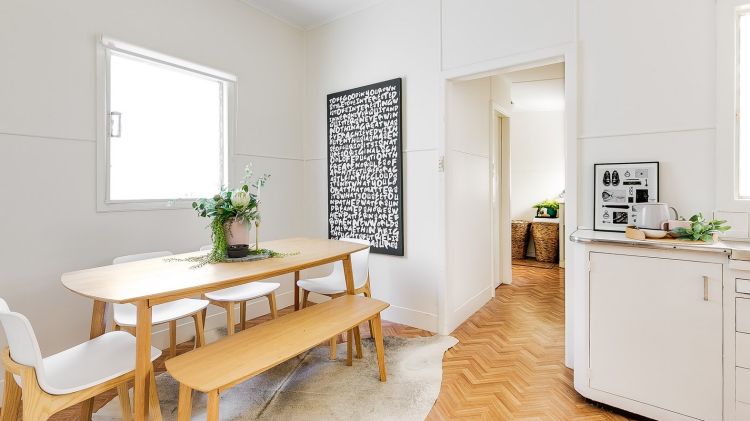May moved into her Rozelle home in 1927. This is her story.
This is old news, but many of you won’t have heard it before. In fact, most readers weren’t born when May Bartlett moved into 1 Callan Street Rozelle as a 7-year-old.
It was 1927 and May’s grandparents had come into a small inheritance – just enough to pay £430 for the one-bedroom cottage.
“My grandfather divided the front room to make a bedroom for me,” May told Domain. “Callan Street was a dirt road with no formed footpaths, just dirt and rubble. The bottom of Callan Street was a dairy with cows feeding on the grass field, and Victoria Road was called Weston Road and was a two-lane road with tramlines up the middle.”
We often write about the gentrification of Sydney’s working class suburbs, but few of us stay put long enough to watch it unfold before our eyes. May lived in this humble cottage for 90 of her 97 years, only moving on to a nursing home four months ago.
 1 Callan Street, Rozelle. Photo: Supplied
1 Callan Street, Rozelle. Photo: Supplied
“It broke my heart to leave it,” she told Domain. “I thought I would leave it when I died, like my granny did.”
While there are a thousand precious memories wrapped up in the cherished home, the house May lived in most of her life will go to auction next week.
“Rozelle was very much a working class suburb,” says May. “You never heard of anyone going to university. We nearly all left school at 14 and worked in factories.”
 May Bartlett moved into this Rozelle cottage in 1927 as a 7-year-old. Photo: Supplied
May Bartlett moved into this Rozelle cottage in 1927 as a 7-year-old. Photo: Supplied
May’s grandfather was a carpenter and during the depression he would go house to house with his tools in a bag slung over his shoulder, looking for odd jobs.
May remembers attending the monthly jumble sales at the Methodist Church Hall in Denison Street where crowds jostled to find suitable second-hand clothes and shoes.
Back at home May’s gran would unpick every seam, wash the fabrics and then sew up outfits on her old Treadle sewing machine.
 The Rozelle cottage May moved into in 1927. Photo: Supplied
The Rozelle cottage May moved into in 1927. Photo: Supplied
Deliveries were made by horse and cart bringing bread, milk and clothes props to hold up your string of wet washing. Motor vehicles were few and far between, but May’s favourite childhood memory is of the tip lorry.
“When I’d hear the truck turn the corner I’d yell out to all the kids in the street and children would tumble out of houses and join me in the race to the tip,” says May. “As they were unloading we were finding treasures to take home. For us girls the best tips would be the ones from the clothing factories and milliners so we might find scraps of pretty materials, bits of ribbon etc to dress up our penny kewpie dolls which was about all we had.”
May says when she looks at King Georges Park today, she can see “all the goodies under that beautiful grass.”
 1 Callan Street, Rozelle. Photo: Supplied
1 Callan Street, Rozelle. Photo: Supplied
May also recalls learning to swim in the Parramatta River. “There were free tidal baths down the park and that is where all Rozelle children learnt to swim,” she says.
“To see if the tide was right I would climb on the roof of the outdoor toilet and see down to the park if the river was at high tide. Mums would come down with toddlers but usually the children were unsupervised and learnt to swim by teaching themselves.”
After May got married in 1947, her husband Jim moved in to Callan Street to help care for May’s gran in her final years. In 1954 Jim pulled down the back of the cottage to make room for a new kitchen, dining room and bathroom.
 1 Callan Street, Rozelle. Photo: Supplied
1 Callan Street, Rozelle. Photo: Supplied
“He worked at CSR in Pyrmont as a boiler maker and would do overtime on weekends for extra money to buy the materials for the renovations,” says May. “It was a slow process because we just built as we could afford to pay for it.”
The couple raised their two girls in the three-bedroom home. But it wasn’t until well after their daughters left home in the 1970s that Rozelle began to wriggle free off its working class roots. Local industry closed down and the area experienced a housing boom in the 1990s as land was rezoned for residential development.
May loves the suburb – and Callan Street in particular – in all its guises.
 1 Callan Street, Rozelle. Photo: Supplied
1 Callan Street, Rozelle. Photo: Supplied
“There’s such a good feeling to living in this street,” she says. “I’ve been very blessed.”
